Cool and wet in the Northwest, warmer and drier in the East
- Overall (using provisional data from the Island of Ireland dataset*), August 2024 had an average temperature of 15.47°C, which is 0.20 °C above the most recent 1991-2020 long-term average (LTA), 0.28 °C above the 1981-2010 LTA and 0.79 °C above the 1961-1990 LTA for August.
- August 2024 was ranked 35th warmest in the 125 year dataset and the coldest since August 2018. August 1995 was the warmest August on record with an average temperature of 17.75 °C and August 1912 was the coldest August with an average temperature of 11.63 °C (112 years ago).
- Provisional gridded rainfall data for Ireland suggests August 2024 saw 114% (117 mm) of its 1981-2010 LTA rainfall and 113% of its 1991-2020 LTA.
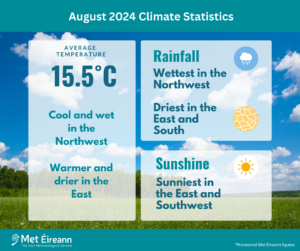
August 2024 Climate Statistics
August 2024 saw Ireland positioned in between low pressure to the north and northwest and high pressure to the south and southeast for most of the month. Numerous frontal rain bands crossed the country from the west interspersed with showery periods, with the airflow mostly between southerly and westerly. This setup brought the bulk of the rainfall to the West and Northwest of the country, with the South and East having a relatively dry month. Winds were strong for August, especially during the second half of the month. Temperatures were near average overall, coolest in the West and Northwest, warmest in the East. There were a few brief periods during the month where the pattern changed. On one occasion a ridge of high pressure built north over Ireland temporarily on Saturday 10th August followed by a surge of very warm air from the south on Sunday 11th. This in turn led to a quick breakdown with an outbreak of intense thunderstorm activity across the western half of the country late on Sunday 11th and into Monday 12th. Storm Lilian, named by the Met Office (UK), crossed the southern half of the country late on Thursday 22nd and early Friday 23rd bringing widespread heavy rain and strong winds. High pressure built north again towards the end of the month bringing a drier and sunnier finish to the month.
Rainfall: Wettest in the Northwest, driest in the East and South
Percentage of 1981-2010 Long-Term Average (LTA) rainfall values were variable across the country. They ranged from 50% (the month’s lowest monthly rainfall total of 36.6 mm) at Dublin Airport, Co Dublin to 204% (monthly rainfall total of 208.1 mm) at Belmullet, Co Mayo (its wettest August since 1992). Monthly rainfall totals were as much as 257.5 mm (194% of its LTA) at Newport, Co Mayo (its 2nd wettest August on record and wettest since 1985 (record length 65 years)). The month’s wettest day was also recorded at Newport, Co Mayo with 34.6 mm on Sunday 4th. The number of rain days* ranged from 14 days at Phoenix Park, Co Dublin to 29 days at Malin Head, Co Donegal. The number of wet days* ranged from 8 days at both Phoenix Park, Co Dublin and Casement Aerodrome, Co Dublin to 25 days at Athenry, Co Galway. The number of very wet days* ranged from zero days at Moore Park, Co Cork to 13 days at Newport, Co Mayo. Two stations had their wettest August on record. These were Malin Head, Co Donegal with 181.3 mm (record length 69 years) and Knock Airport, Co Mayo with 215.4 mm (record length 28 years).
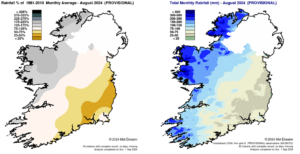
Rainfall % of 1981 – 2010 Monthly Average for August 2024 (Provisional) Total Monthly Rainfall (mm) for August 2024 (Provisional)
Temperature: Coolest in the West and Northwest, warmest in the East
The majority of mean air temperatures across the country were below their LTA for the month. Deviations from mean air temperature ranged from -0.7 °C (14.0 °C mean temperature) at Markree, Co Sligo to 0.6 °C (15.8 °C mean temperature) at Phoenix Park, Co Dublin. Mean temperatures for the month ranged from 13.3 °C (0.3 °C below its LTA) at Knock Airport, Co Mayo to 15.8 °C at both Phoenix Park, Co Dublin (0.6 °C above its LTA) and Shannon Airport, Co Clare (0.3°C below its LTA). The month’s highest temperature was reported at Casement Aerodrome, Co Dublin on Sunday 11th with a temperature of 24.3 °C. The month’s lowest air minimum was recorded on Saturday 31st at Mount Dillon, Co Roscommon with 3.5 °C while the lowest grass minimum was -0.1 °C reported at Dublin Airport, Co Dublin on Friday 30th. There was no air frost reported this month. Only one station, Dublin Airport, Co Dublin, reported ground frost on one day this month. It was the coldest August since 2018 at eight stations and coldest since 2017 at twelve stations.
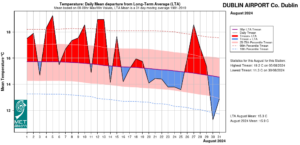
Dublin Airport, Co Dublin Temperature: Daily mean departure from LTA for August 2024 based on 09-09hr Max/Min values.
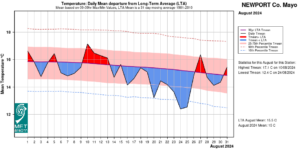
Newport, Co Mayo Temperature: Daily mean departure from LTA for August 2024 based on 09-09hr Max/Min values.
Sunshine: Sunniest in the East and Southwest
Sunshine values were variable across the country. Percentage of monthly sunshine values ranged from 111% (monthly sunshine total of 156.8 hours) at Shannon Airport, Co Clare to 125% (the month’s highest monthly sunshine total of 188.2 hours) at Casement Aerodrome, Co Dublin. Monthly sunshine totals were lowest at Malin Head, Co Donegal with 121.2 hours (No LTA comparison*). The highest number of daily sunshine hours recorded this month was 12.8 hours at Johnstown Castle, Co Wexford on Friday 30th. The number of dull days2 ranged from 4 days at both Shannon Airport, Co Clare and Cork Airport, Co Cork to 8 days at Belmullet, Co Mayo.
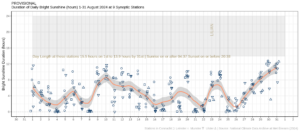
Hours of Bright Sunshine observed at nine stations for each day of the month of August 2024, grouped by province relative to the highest number of hours possible by end of month (shaded box)
Wind: Gales reported on several days including with storm Lilian
Monthly mean wind speeds ranged from 5.9 knots (10.9 km/h) at Moore Park, Co Cork to 17.8 knots (33.0 km/h) at Mace Head, Co Galway. Gales were reported on Monday 19th, Tuesday 20th, Wednesday 21st, Thursday 22nd and Friday 23rd. The number of days with gale force winds ranged from zero days at a few stations to 3 days at Roche’s Point, Co Cork. There were no strong gales or storms reported this month. The month’s highest 10-minute mean wind speed of 37 knots (69 km/h) was reported at both Belmullet, Co Mayo on Wednesday 21st and at Roche’s Point, Co Cork on Friday 23rd during storm Lilian. The highest gust was 52 knots (96 km/h) reported at Roche’s Point, Co Cork on Friday 23rd during storm Lilian. Six stations had their highest mean wind for August on record (record lengths ranging between 13 and 20 years). These were Mace Head, Co Galway, Sherkin Island, Co Cork, Dunsany, Co Meath, Gurteen, Co Tipperary, Athenry, Co Galway and Finner, Co Donegal. Six other stations had their highest mean wind for August since at least 1989.
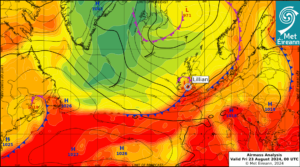
Airmass Analysis chart 00 UTC 23 August 2024: Storm Lilian crossing the south of Ireland from west to east
The full report is available here.

Extreme values for August 2024 at synoptic stations
*Issued by Met Éireann on Tuesday 3rd September 2024. This report is based on available preliminary data from 25 principal weather stations operated by Met Éireann. Synoptic station data is midnight to midnight UTC. Long-Term Averages (LTAs) and “average” refer to the period 1981-2010 unless stated. A rain day is a day on which 0.2 mm or more of rainfall is measured. A wet day is a day with 1.0 mm or more of rainfall. A dull day is a day with less than 0.5 hours of sunshine. A very wet day is a day with 10.0 mm or more of rainfall. Climatological dry periods – An absolute drought is a period of 15 or more consecutive days to none of which is credited 0.2 mm or more of precipitation. A partial drought is a period of at least 29 consecutive days, the mean daily rainfall of which does not exceed 0.2 mm. A dry spell is a period of 15 or more consecutive days to none of which is credited 1.0 mm or more of precipitation (i.e. daily tot < 1.0 mm). A heatwave occurs where there are 5 consecutive days or more with maximum temperature over 25°C (that is, a daily maximum screen air temperature > 25° C). The Island of Ireland dataset is 125 years long and runs between 1900 and 2023. For this dataset the long term averages from the 1961-1990 reference period are used for comparison as is standard for long-term climate change assessments. *Sunshine data is from the Autosol Network. LTAs for these sites are currently not used for comparison purposes. For more information, contact Met Éireann at 01-8064200 or e-mail: enq@met.ie